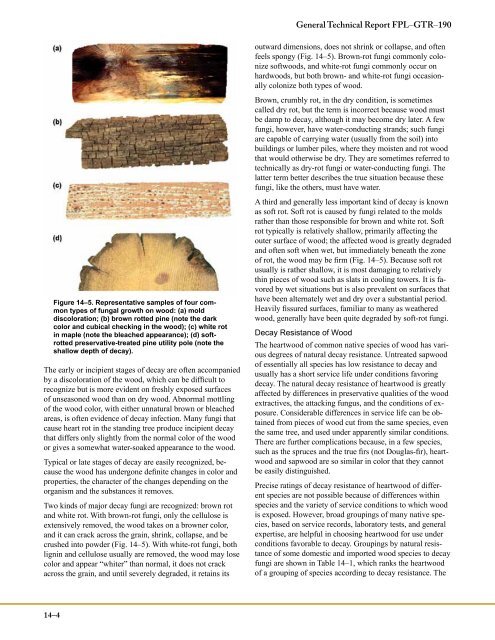Biodeterioration of Wood - Forest Products Laboratory
Biodeterioration of Wood - Forest Products Laboratory
Biodeterioration of Wood - Forest Products Laboratory
You also want an ePaper? Increase the reach of your titles
YUMPU automatically turns print PDFs into web optimized ePapers that Google loves.
Figure 14–5. Representative samples <strong>of</strong> four common<br />
types <strong>of</strong> fungal growth on wood: (a) mold<br />
discoloration; (b) brown rotted pine (note the dark<br />
color and cubical checking in the wood); (c) white rot<br />
in maple (note the bleached appearance); (d) s<strong>of</strong>trotted<br />
preservative-treated pine utility pole (note the<br />
shallow depth <strong>of</strong> decay).<br />
The early or incipient stages <strong>of</strong> decay are <strong>of</strong>ten accompanied<br />
by a discoloration <strong>of</strong> the wood, which can be difficult to<br />
recognize but is more evident on freshly exposed surfaces<br />
<strong>of</strong> unseasoned wood than on dry wood. Abnormal mottling<br />
<strong>of</strong> the wood color, with either unnatural brown or bleached<br />
areas, is <strong>of</strong>ten evidence <strong>of</strong> decay infection. Many fungi that<br />
cause heart rot in the standing tree produce incipient decay<br />
that differs only slightly from the normal color <strong>of</strong> the wood<br />
or gives a somewhat water-soaked appearance to the wood.<br />
Typical or late stages <strong>of</strong> decay are easily recognized, because<br />
the wood has undergone definite changes in color and<br />
properties, the character <strong>of</strong> the changes depending on the<br />
organism and the substances it removes.<br />
Two kinds <strong>of</strong> major decay fungi are recognized: brown rot<br />
and white rot. With brown-rot fungi, only the cellulose is<br />
extensively removed, the wood takes on a browner color,<br />
and it can crack across the grain, shrink, collapse, and be<br />
crushed into powder (Fig. 14–5). With white-rot fungi, both<br />
lignin and cellulose usually are removed, the wood may lose<br />
color and appear “whiter” than normal, it does not crack<br />
across the grain, and until severely degraded, it retains its<br />
14–4<br />
General Technical Report FPL–GTR–190<br />
outward dimensions, does not shrink or collapse, and <strong>of</strong>ten<br />
feels spongy (Fig. 14–5). Brown-rot fungi commonly colonize<br />
s<strong>of</strong>twoods, and white-rot fungi commonly occur on<br />
hardwoods, but both brown- and white-rot fungi occasionally<br />
colonize both types <strong>of</strong> wood.<br />
Brown, crumbly rot, in the dry condition, is sometimes<br />
called dry rot, but the term is incorrect because wood must<br />
be damp to decay, although it may become dry later. A few<br />
fungi, however, have water-conducting strands; such fungi<br />
are capable <strong>of</strong> carrying water (usually from the soil) into<br />
buildings or lumber piles, where they moisten and rot wood<br />
that would otherwise be dry. They are sometimes referred to<br />
technically as dry-rot fungi or water-conducting fungi. The<br />
latter term better describes the true situation because these<br />
fungi, like the others, must have water.<br />
A third and generally less important kind <strong>of</strong> decay is known<br />
as s<strong>of</strong>t rot. S<strong>of</strong>t rot is caused by fungi related to the molds<br />
rather than those responsible for brown and white rot. S<strong>of</strong>t<br />
rot typically is relatively shallow, primarily affecting the<br />
outer surface <strong>of</strong> wood; the affected wood is greatly degraded<br />
and <strong>of</strong>ten s<strong>of</strong>t when wet, but immediately beneath the zone<br />
<strong>of</strong> rot, the wood may be firm (Fig. 14–5). Because s<strong>of</strong>t rot<br />
usually is rather shallow, it is most damaging to relatively<br />
thin pieces <strong>of</strong> wood such as slats in cooling towers. It is favored<br />
by wet situations but is also prevalent on surfaces that<br />
have been alternately wet and dry over a substantial period.<br />
Heavily fissured surfaces, familiar to many as weathered<br />
wood, generally have been quite degraded by s<strong>of</strong>t-rot fungi.<br />
Decay Resistance <strong>of</strong> <strong>Wood</strong><br />
The heartwood <strong>of</strong> common native species <strong>of</strong> wood has various<br />
degrees <strong>of</strong> natural decay resistance. Untreated sapwood<br />
<strong>of</strong> essentially all species has low resistance to decay and<br />
usually has a short service life under conditions favoring<br />
decay. The natural decay resistance <strong>of</strong> heartwood is greatly<br />
affected by differences in preservative qualities <strong>of</strong> the wood<br />
extractives, the attacking fungus, and the conditions <strong>of</strong> exposure.<br />
Considerable differences in service life can be obtained<br />
from pieces <strong>of</strong> wood cut from the same species, even<br />
the same tree, and used under apparently similar conditions.<br />
There are further complications because, in a few species,<br />
such as the spruces and the true firs (not Douglas-fir), heartwood<br />
and sapwood are so similar in color that they cannot<br />
be easily distinguished.<br />
Precise ratings <strong>of</strong> decay resistance <strong>of</strong> heartwood <strong>of</strong> different<br />
species are not possible because <strong>of</strong> differences within<br />
species and the variety <strong>of</strong> service conditions to which wood<br />
is exposed. However, broad groupings <strong>of</strong> many native species,<br />
based on service records, laboratory tests, and general<br />
expertise, are helpful in choosing heartwood for use under<br />
conditions favorable to decay. Groupings by natural resistance<br />
<strong>of</strong> some domestic and imported wood species to decay<br />
fungi are shown in Table 14–1, which ranks the heartwood<br />
<strong>of</strong> a grouping <strong>of</strong> species according to decay resistance. The
















